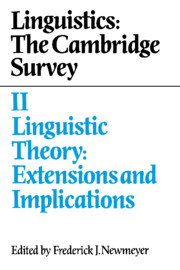Book contents
- Frontmatter
- Contents
- Contributors
- Preface
- 1 Extensions and implications of linguistic theory: an overview
- 2 Grammar and language processing
- 3 Grammatical principles of first language acquisition: theory and evidence
- 4 Second language acquisition and grammatical theory
- 5 Brain structures and linguistic capacity
- 6 Abnormal language acquisition and the modularity of language
- 7 Grammatical aspects of speech errors
- 8 Grammar and conversational principles
- 9 Discourse analysis: a part of the study of linguistic competence
- 10 Speech act distinctions in grammar
- 11 Computer applications of linguistic theory
- 12 Metrics and phonological theory
- 13 Grammatical theory and signed languages
- 14 The linguistic status of creole languages: two perspectives
- 14.I Creole languages and the bioprogram
- 14.II Are creoles a special type of language?
- 14.III A dialog concerning the linguistic status of creole languages
- Subject index
- Name index
- Contents of volumes I, III, and IV
2 - Grammar and language processing
Published online by Cambridge University Press: 08 February 2010
- Frontmatter
- Contents
- Contributors
- Preface
- 1 Extensions and implications of linguistic theory: an overview
- 2 Grammar and language processing
- 3 Grammatical principles of first language acquisition: theory and evidence
- 4 Second language acquisition and grammatical theory
- 5 Brain structures and linguistic capacity
- 6 Abnormal language acquisition and the modularity of language
- 7 Grammatical aspects of speech errors
- 8 Grammar and conversational principles
- 9 Discourse analysis: a part of the study of linguistic competence
- 10 Speech act distinctions in grammar
- 11 Computer applications of linguistic theory
- 12 Metrics and phonological theory
- 13 Grammatical theory and signed languages
- 14 The linguistic status of creole languages: two perspectives
- 14.I Creole languages and the bioprogram
- 14.II Are creoles a special type of language?
- 14.III A dialog concerning the linguistic status of creole languages
- Subject index
- Name index
- Contents of volumes I, III, and IV
Summary
Grammars
Do generative grammars characterize the linguistic knowledge used in language comprehension? This question has received several distinct answers in the psycholinguistic literature. In the early 1960s attempts were made to test transformational grammars directly, without embedding them in an explicit processing model (see Fodor, Bever & Garrett 1974: ch. 5 for an excellent review). The failure of these attempts presented a serious problem for psycholinguists. Considerable psychological evidence showed that the structures the grammar attributes to sentences are psychologically real, even if the transformational rules of the 1960-style grammar were not. Since the only known characterization of surface structures was the one provided by transformational grammar, this state of affairs presented an apparent contradiction. In response to this situation, several models of comprehension were developed in which grammatical information was either not used, used haphazardly, along with sundry heuristics and heavy reliance on lexical and world knowledge, or the grammar (specifically syntax) was used only as a last resort when other routes to comprehension failed (Bever 1970; Riesbeck & Schank 1978; see Frazier 1979: ch. 2 for a critical review).
Nevertheless, substantial evidence has accumulated showing that syntactic information is exploited in language comprehension. For example, Forster & Olbrei (1973) show that passives (presented in isolation) take longer to process than corresponding actives regardless of whether the semantic relations are reversible or nonreversible. Flores d'Arcais (1982) found that sentences with syntactic violations take longer to read than well-formed sentences, even when perceivers do not consciously detect the violation.
- Type
- Chapter
- Information
- Linguistics: The Cambridge Survey , pp. 15 - 34Publisher: Cambridge University PressPrint publication year: 1988
- 6
- Cited by



